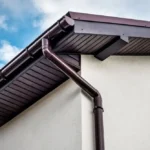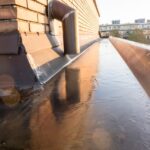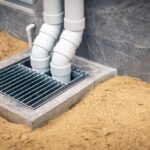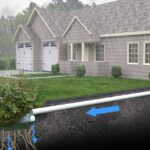When it comes to managing rainwater, many homeowners automatically think of gutters. However, not all buildings have gutters, and the absence of these traditional systems can pose unique challenges. Fortunately, there are effective alternatives for roof drainage for buildings with no gutters. These innovative solutions ensure that rainwater is directed away from your home, preventing damage and maintaining the structural integrity of your building.
In this article, we will explore various methods to handle roof drainage without relying on gutters. Whether you’re building a new home or looking to upgrade your current system, understanding these options is essential for effective water management.

Why Some Buildings Lack Gutters
There are several reasons why a building might not have gutters. In some architectural styles, gutters are considered aesthetically unpleasing and detract from the design of the building. In other cases, the climate might not necessitate the use of gutters, or the building might be designed with alternative drainage systems in mind. Whatever the reason, it’s crucial to have a plan for managing water runoff.
Architectural Considerations
Certain architectural styles, such as modern or minimalist designs, often forego gutters to maintain clean lines and a sleek appearance. In these cases, alternative drainage solutions are integrated into the overall design of the building. This approach requires careful planning to ensure functionality without compromising aesthetics.
Alternative Roof Drainage Solutions
1. Drip Edge Flashing
Drip edge flashing is a simple yet effective solution for managing roof runoff. This method involves installing a metal strip along the edge of the roof to direct water away from the building. By creating a small overhang, water drips directly to the ground, reducing the risk of water damage to the foundation and walls.
2. Rain Chains
Rain chains are a decorative and functional alternative to traditional downspouts. Originating from Japan, these chains guide water from the roof to the ground, where it can be collected or directed away. Rain chains come in various styles and materials, adding a unique touch to any building’s exterior while effectively managing water flow.
3. Ground Gutters
Ground gutters, also known as French drains, are installed at ground level to divert water away from the foundation. This system involves a trench filled with gravel and a perforated pipe that collects and directs water to a designated drainage area. Ground gutters are particularly useful in areas prone to heavy rainfall or flooding.
4. Roof Overhangs
Extending the roof overhang is another method for managing water runoff. By increasing the distance between the roof edge and the walls, rainwater is directed further away from the building. This solution is most effective in areas with moderate rainfall and requires careful design to ensure structural stability.
Benefits of Gutterless Roof Drainage Systems
Opting for a gutterless roof drainage system offers several advantages. These solutions are often more aesthetically pleasing, as they eliminate the need for bulky gutters and downspouts. Additionally, they can be more cost-effective, requiring less maintenance and reducing the risk of damage from clogged gutters.
Low Maintenance
Without gutters to clean and maintain, homeowners can enjoy a more carefree experience when it comes to roof drainage. Systems like drip edges and rain chains require minimal upkeep, making them an attractive option for those looking to simplify home maintenance.
Enhanced Aesthetics
For homeowners who prioritize design, gutterless systems offer a seamless look that enhances the overall appearance of the building. With options like rain chains and hidden ground gutters, it’s possible to achieve both functionality and beauty.
Considerations for Implementing Gutterless Systems
While gutterless systems offer many benefits, it’s important to carefully consider your specific needs and environment before implementation. Factors such as climate, landscape, and building design will influence the effectiveness of each solution.
Climate and Weather
In regions with heavy rainfall, certain gutterless systems may not be sufficient to handle the volume of water. It’s crucial to assess the average precipitation in your area and choose a solution that can effectively manage the expected water flow.
Building Design
The design of your home will also play a significant role in determining the best drainage solution. Consider the slope of your roof, the position of windows and doors, and any existing drainage features when selecting a system.

Conclusion
For buildings without gutters, innovative roof drainage solutions offer a practical and aesthetically pleasing way to manage water runoff. By exploring options such as drip edge flashing, rain chains, ground gutters, and roof overhangs, homeowners can protect their property from water damage while maintaining the beauty of their home.
For more information on managing roof drainage, visit roof drainage system. Additionally, consider exploring resources like roof water runoff for further tips on ensuring proper drainage in different environments.
This article contains affiliate links. We may earn a commission at no extra cost to you.







